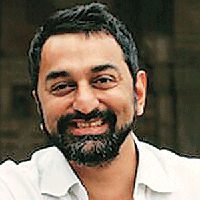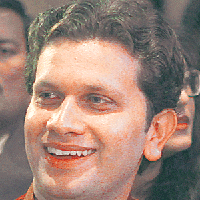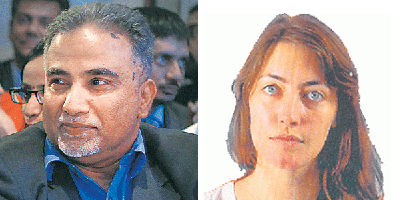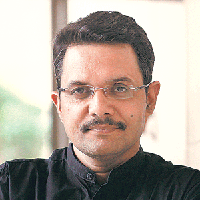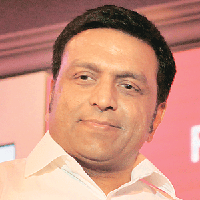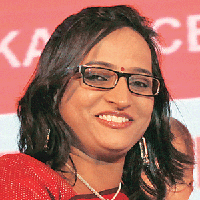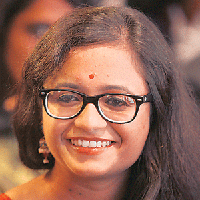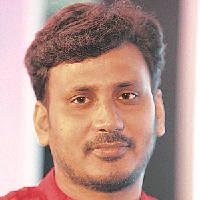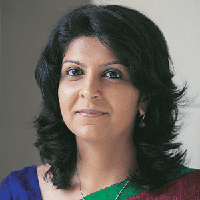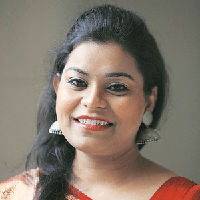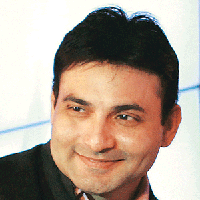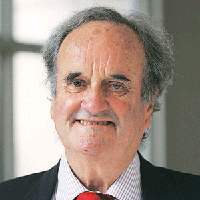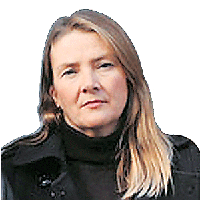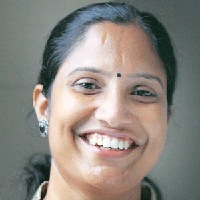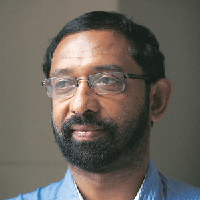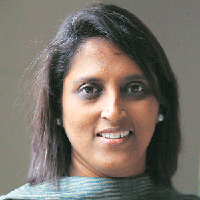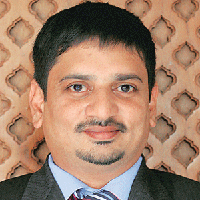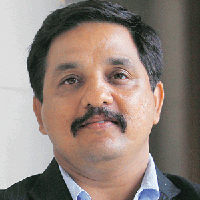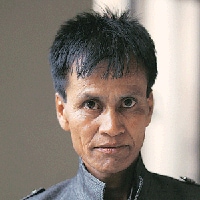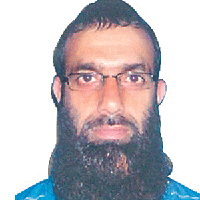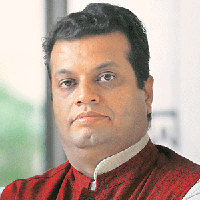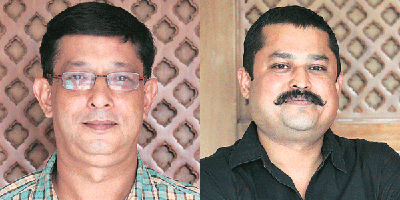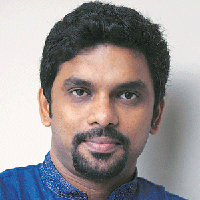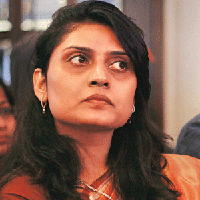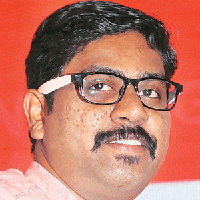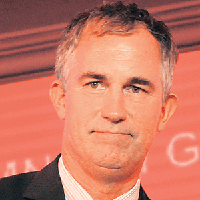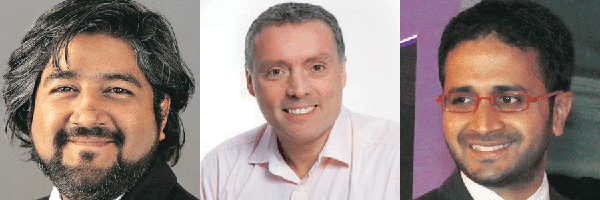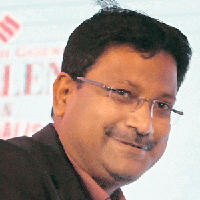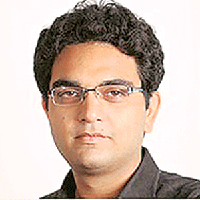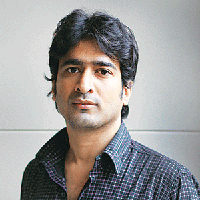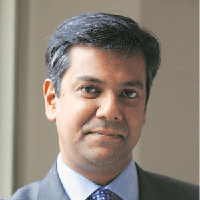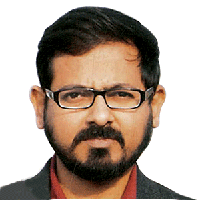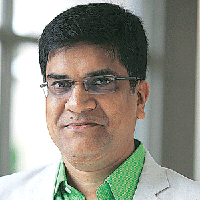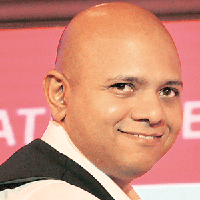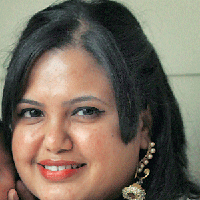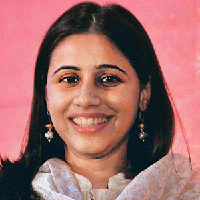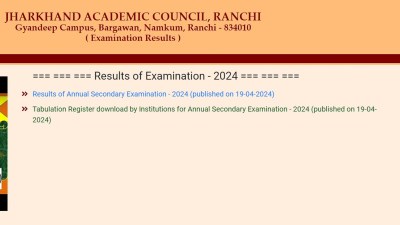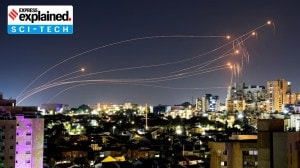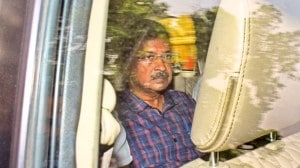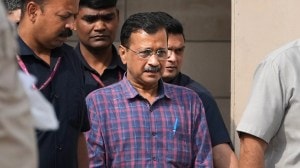- India
- International
Ramnath Goenka Awards: The Storytellers
The winners of the seventh Ramnath Goenka Awards for Excellence in Journalism for 2011 and 2012.
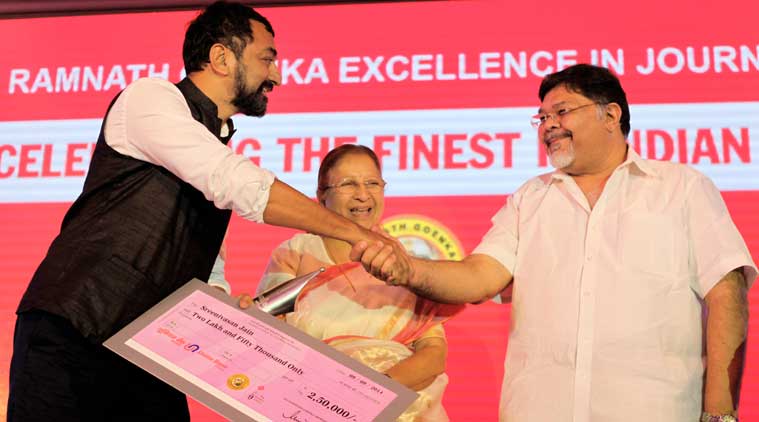 Sreenivasan Jain of NDTV 24X7 getting the Journalist of the year 2012 award from the Lok Sabha Speaker Sumitra Mahajan and Viveck Goenka, CMD of Express Group during the Ramnath Goenka Excellence in Journalism awards in New Delhi on Sept 9th 2014. (Source: Express photo by Ravi Kanojia)
Sreenivasan Jain of NDTV 24X7 getting the Journalist of the year 2012 award from the Lok Sabha Speaker Sumitra Mahajan and Viveck Goenka, CMD of Express Group during the Ramnath Goenka Excellence in Journalism awards in New Delhi on Sept 9th 2014. (Source: Express photo by Ravi Kanojia)
From a story on the politics of a riot to the life of bare-all celebs, from a series on new jobs in India to one on untouchability in a school in Bihar — these were stories waiting to be told. The winners of the seventh Ramnath Goenka Awards for Excellence in Journalism for 2011 and 2012 did just that.
JOURNALIST OF THE YEAR – Sreenivasan Jain
In a world pre-occupied with breaking news and centred around studio rooms, Sreenivasan Jain’s show Truth vs Hype, which started in 2011, aimed at bringing stories straight from the field. From covering the aftermath of the revolution in Egypt to investigating the riots in Assam, from exposing the nexus between miners, real-estate players and politicians in Goa to a series on the coal scam, the show kept its focus on hard news. “From reporting from the grassroots, it evolved into an investigative show which had a combination of ground reports, investigation, and political and socio-economic issues,” Jain says.
PRAKASH KARDALEY MEMORIAL AWARD FOR CIVIC JOURNALISM
# 2011 (PRINT) – Radheshyam Bapu Jadhav – The Times of India
Jadhav’s stories focused on the urban decay of Pune — vanishing open spaces, mounds of garbage and the lack of space for cyclists and walkers. He also wrote about how poor civic hygiene was letting down the city’s residents.
# 2012 (PRINT) – Kunal Rajnikant Purohit – Hindustan Times
He exposed how Mumbai’s municipal corporation tried to manipulate the city’s land surveys by marking educational buildings and open spaces ‘commercial’. “Later, the Commissioner asked citizens to scrutinise the maps, a first in the history of the corporation”.
UNCOVERING INDIA INVISIBLE# 2011 (PRINT) – Anil Padmanabhan and Cordelia Jenkins – Mint

Their series looked at new jobs in an emerging India — a spa for dogs, the life of a wedding planner, voice modulation classes… “We looked at an outgoing profession and an incoming one and played them as a pair each day,” Padmanabhan says.
# 2012 (PRINT) – Neelesh Misra and Manish Mishra – Gaon Connection
Neelesh Misra and Manish Mishra did a series on young women in Uttar Pradesh breaking free from the shackles that society imposes on them — among them, the story of a girl who has to decide between becoming a teacher and training to be a cop, and how she chooses the latter. “Life in villages has changed a lot and we shed light on stories that are not covered by bigger newspapers. People are now eating chowmein and momos and sleep later than they did. TV has played a big role in this change,” says Manish Mishra.
# 2011 (broadcast) – Umesh Aggarwal – Doordarshan
His documentary ‘Brokering News’ exposed the phenomenon of paid news. “You do not consume everything that you are served. We analysed the reportage on several issues over eight months and identified a pattern in how news items were being influenced,” says Aggarwal.
# 2012 (broadcast) – Alka Atmaram Dhupka – IBN Lokmat
For her work on surrogacy, Dhupkar interviewed foreign tourists, legal experts and the women who were preparing to become surrogate mothers. “Instead of looking at the issue in black and white, I explored the grey too. I tried not to take a stand,” she says.
HINDI
# 2011 (PRINT) – Priyanka Dubey – Tehelka
After Dubey saw a newspaper clip about the burning of a rape victim in MP, she compiled a list of such cases. “My editors were shocked when I told them that in one year, at least 15 girls had been burnt alive in Bundelkhand after rape or attempted rape.”
# 2012 (PRINT) – Brijesh Singh – Tehelka
A question in the J&K Assembly about the number of refugees in the state prompted Singh to find out more. A trip to the state revealed that there were more than 17,00,000 ‘state refugees’. “It was shocking,” he says.
# 2012 (broadcast) – Sharik Rahman Khan – NDTV IndiaKhan’s documentary ‘Kyu bhadki Bareilly’ exposed the political nexus that led to the riots in 2011. “The media only shows images of people suffering after the riots but no one shows how politics works behind the scenes to trigger these riots,” says Khan. His film did just that.
FILM AND TELEVISION JOURNALISM
# 2011 (PRINT) – Dipti Nagpaul – The Indian Express
Nagpaul moved beyond the glitz of Bollywood to seek out the world of ‘extras’. Her story also spoke about the hierarchy among these artistes. “While we may feel that they are replaceable, these actors know their rights,” Nagpaul says.
# 2012 (PRINT) – Shweta Thakur Nanda – The Week
“Those days, everyone was joining Twitter and Poonam Pandey had a lot of followers,” says Nanda. This set her working on a story on other bare-all celebs, among them Sherlyn Chopra, who said she had lost count of the surgeries she had undergone to “perfect” her body.
# 2012 (broadcast) – Yasser Usman – ABP News
Much had been written about Guru Dutt the actor, but very little of Dutt the romantic. “This is what prompted us to do a story on his relationships, among them with Geeta Roy and Waheeda Rehman,” says Usman.
BOOKS (NON-FICTION)
# 2011 – Mark Tully – Non-stop India, Penguin
For his follow-up to his bestseller No Full Stops, Tully turned the spotlight on rural India, including narratives about the Naxal movement, religious fundamentalism, and caste conflict, among others. “There was some criticism in the media that I had pointed out problems, not solutions,” says Tully.
# 2012 – Adrian Levy and Cathy Scott-Clark – The Meadow, Penguin
In 1995, militants kidnapped six western tourists in J&K. “Through this one small case, a reader could see the entire Kashmir imbroglio,” says Levy. In their book The Meadow, Levy and Scott-Clark recount the massacres in J&K perpetrated by militants, foreign fighters, soldiers and spies. The duo are now working on their sixth book, The Exile, which will chart the passage of al-Qaeda’s caravan from inside the caves of Tora Bora to the plains of Pakistan.
REGIONAL LANGUAGES
# 2011 (PRINT) – Reji R Nair – Mathrubhumi
Nair writes about the myths and fears associated with organ donation and the lack of coordination among different agencies. In Kerala, 20,000 patients die of renal and liver diseases every year. A donation could have saved at least some of them, she says.
# 2012 (PRINT) – Soman T – Mathrubhumi
When Soman T set out to cover the condition of migrant workers in Kerala, there was hardly any statistical data. While a change in the social fabric was evident, he says, the issue had failed to catch the government’s attention.
# 2011 (broadcast) – Siddu Biradar – TV9
Biradar found out that there were at least 3,000 malnourished children in Karnataka’s Devadurga taluka. The reason, he found out, was the poor quality of food supplied by a Tamil Nadu contractor. After Biradar’s story, the state launched more than 20 schemes for Devadurga’s children.
# 2012 (broadcast) – Prajakta R Dhulap – IBN Lokmat
‘Nituchya Lagnachi Dusari Gost (The second story of Nitu’s marriage)’ is a story of early marriages in Marathwada and how young girls have to struggle to convince their parents to let them study. Dhulap travelled to Marathwada and worked with the girls for a month. “All these girls told me about Nitu, a girl who was married off at 13. She died soon after she became pregnant,” she says.
SPORTS JOURNALISM
# 2011 (PRINT) – Anand Vasu – Sports Illustrated India
Vasu got Rahul Dravid and V V S Laxman to talk about their growth in the Indian cricket team and share stories of their two-decade-long friendship. “Rahul and Laxman understand their own game so thoroughly that the challenge was to set up an atmosphere in which they
could surprise themselves and each other,” he says.
# 2012 (PRINT) – Shantanu Guha Ray – India Today
India had been wiped out during its tour of Australia in 2012 and Ray wanted to take a hard look at why Indian cricketers fail on overseas tours. “We got international voices to share their insights. Usually we just hear about the problems from the cricketers themselves, and writers get carried away by what they say,” says Ray.
# 2011 (broadcast) – Vinayak Deepak Gaikwad – IBN Lokmat
In Kolhapur, Maharashtra, an area primarily known for the wrestlers it produces, Vinayak Deepak Gaikwad stumbled on some obscure football clubs. “I took leave from work and attended a tournament to see how these clubs compete.” The result is a delightful story on Kolhapur’s football clubs.
# 2012 (broadcast) – Vimal Mohan – NDTV India
“It was while covering the Beijing Olympics that I decided to focus on why we weren’t winning more medals. Later, I went to Vijender Singh’s village in Haryana and reported about the training conditions of athletes. My intention was just to bring to light how sports should be about long-term investment.”
REPORTING FROM J&K AND THE NORTHEAST
# 2011 (PRINT) – Lambok Thabah – U Nongsain Hima
Thabah did a series of stories that highlighted the misappropriation of PDS rice and sugar in Meghalaya with a focus on 20 families who had been denied these items for years. Thabah broke the story in May and continued reporting about the matter until it was resolved in August.
# 2012 (PRINT) – Bashaarat Masood – The Indian Express
Bashaarat Masood’s story brought to light the case of five grieving families who lost their kin in the Pathribal fake encounter on March 25, 2000. The five had been described as foreign militants by the Army. Bashaarat also took a hard look at the possible rise of a new breed of militants in Kashmir.
# 2011 (broadcast) – Sreenivasan Jain – NDTV 24×7
In 2011, Jain went to Manipur to report on the 100-day economic blockade brought about by a tussle between the Kukis and the Nagas in the state. “We were looking at the anatomy of a blockade,” he says.
# 2012 (broadcast) – Maya Mirchandani – NDTV 24×7
When the 2012 Kokrajhar clashes erupted in Assam, Maya Mirchandani did a series of stories that dealt with the complexities involved. “We had to walk the fine line between calling the clashes communal or ethnic. The issue was also largely caused by an identity crisis faced by the parties involved,” she says.
ENVIRONMENTAL REPORTING
# 2011 (PRINT) – R Samban – Deshabhimani
Samban’s series on the encroachment of Vellayani Kayal, a freshwater lake in Thiruvananthapuram, highlighted how real-estate developers and land mafia had connived to choke a lake that’s now “just a third of its size”.
# 2012 (PRINT) – Vinod Kumar Menon – Mid-Day
A water shortage in a village near Mumbai had led to the death of a woman. Menon’s series uncovered the causes behind the scarcity. “My reports were recognised…and as a result, the village now gets 5,000 litres of direct water supply,” he says.
# 2011 (broadcast) – Arti Dattatray Kulkarni – IBN Lokmat
When 20 power plants were slotted to come up on a belt along the Konkan coast, Kulkarni did a story on the “massive ecological crisis”. “Though land acquisition was underway for many of these, there were no environmental impact assessment reports to fall back on,” she says.
# 2012 (broadcast) – Ajay Suri and Asif Khan – National Geographic
Their film probed the man-animal conflict in Uttarakhand and how leopards and elephants in the hill station are increasingly feeling the effects of urbanisation. “We were both working with Star News when we realised that we wanted to follow our passion for wildlife and the environment. We decided to start making films and documentaries that highlight environmental issues,” says Suri.
BUSINESS AND ECONOMIC JOURNALISM
# 2011 (PRINT) – Dinesh Unnikrishnan – Mint
His stories brought to the fore the crisis in the microfinance sector — an area largely unexplored by business journalists until then. “My stories were about the crisis and how it affected companies and people,” he says.
# 2012 (PRINT) – Nidhi Verma – Reuters
“The journey to cover Iran began in 2008 when I reported that Reliance Industries halted export of fuels to Iran, as foreign bankers stopped offering credit under pressure from Western nations over Tehran’s nuclear programme,” says Verma.
# 2011 (broadcast) – Karma Paljor – CNN-IBN
Karma Paljor travelled for six months around the country, talking to experts and ex-Air India officials to piece together the story of an airline in turbulence. “It was shocking to discover how grossly mismanaged everything was,” he says.
# 2012 (broadcast) – Manu C Kumar – Manorama News
His incisive story unveiled malpractices while importing from China and pressed for tax proficiency.
FOREIGN CORRESPONDENT COVERING INDIA
# 2011 (PRINT) – Stephanie Nolen – The Globe and Mail
Her series, ‘Breaking Caste’, highlighted issues of caste and gender at the Prerna Residential School for Mahadalit girls in Bihar. “There was little discussion about the fact that half the country was effectively shut out of the progress being made.”
# 2012 (PRINT) – Victor John Mallet – Financial Times
A year-and-a-half before the LS polls, Mallet wrote ‘The man who would be PM’ about Narendra Modi. He went to Gujarat when Modi was on a statewide yatra. “I thought the best way to meet him would be to intercept him,” he says.
INVESTIGATIVE REPORTING
# 2011 (PRINT) – Surbhi Khyati – The Indian Express
A review of the National Rural Health Mission in UP revealed a number of wrongdoings between 2009 and 2011 when Babu Singh Kushwaha was minister. A series of stories exposed the web of illegal contracts and fund diversion.
# 2012 (PRINT) – Mehul Srivastava, Andrew Macaskill and Adi Narayan – Bloomberg News
Their story highlights how India’s hungry children are “likely to have lower cognitive skills, suffer from chronic illnesses and die prematurely”. It notes how the poor starve because corruption diverts $14.5 billion worth of food from hungry mouths.
# 2011 (broadcast) – Jajati Karan – CNN-IBN
Around 2010, though illegal mining became national news, there were very few reports from the ground. Karan simply took a camera and went to the field. The terrain was treacherous, but he stuck on. “It took me over a month to do the story, but it was worth the effort,”
he says.
# 2012 (broadcast) – Geeta Datta – News X
Her 30-minute-long show explored the state of clinical trials. Looking at nameless doctors and pharma firms based abroad, Dutta set out to uncover the manner in which people were signed up for drug trials, some without being told what they were getting into.
ON-THE-SPOT REPORTING
# 2011 (PRINT) – Manu Pubby – The Indian Express
Pubby’s 16 stories from Cairo, which documented the events as they erupted in Tahrir Square, traced the rise of a ‘new’ Egypt. Pubby closely followed the ouster of Hosni Mubarak and the rise of a new order.
# 2012 (PRINT) – Ashutosh Bhardwaj – The Indian Express
In June 2012, security forces shot dead 17 people in a village in Bijapur in “the biggest Maoist encounter”. Bhardwaj uncovered that among the dead were 15-year-olds who topped their school, and were attending a village gathering when the police opened fire.
# 2011 (broadcast) – Vishnu Som – NDTV 24X7
Som was the only Indian journalist to enter Sendai during the 2011 Japan earthquake. His reports focused on the large-scale loss of life. “We had to return from Sendai to Tokyo, which meant going through Fukushima. We were among the last to be evacuated,” he says.
# 2012 (broadcast) – Arijit Sen – CNN-IBN
In 2012, Sen’s reports from flood-affected Assam exposed the corruption plaguing rescue operations. Sen also investigated allegations of rotten rice being distributed in Majuli. “We travelled extensively to talk to the people and get a proper insight into the issue,” says Sen.
COMMENTARY AND INTERPRETATIVE WRITING
# 2011 (PRINT) – Christophe Jaffrelot – The Caravan
Jaffrelot engages with some of the most discussed themes of the day — on how India needs to deal with contract-driven diplomacy of the West, how one non-violent Muslim changed Swami Aseemanand’s heart and the new breed of political sadhus.
# 2012 (PRINT) – Niranjan Rajadhyaksha – Mint
Rajadhyaksha analysed positive economic data to get the real, and not-so-pretty, picture. He did a comparative study of the economies of India and China and wrote on how India needs to invest in projects that will help support income growth.
REPORTING ON POLITICS AND GOVERNMENT
# 2011 (PRINT) – Vinod K Jose – The Caravan
‘Falling Man’, Jose’s profile of Manmohan Singh, questioned Singh’s reputation as ‘incorruptible’. The corruption conversations then were restricted to A Raja and DMK. “If a cabinet minister was found to be corrupt, the buck stopped with the PM,” Jose says.
# 2012 (PRINT) – Muzamil Jaleel – The indian express
It doesn’t take much to be branded a SIMI activist. The “incriminating material” allegedly found on these men can be something as innocuous as Urdu poetry, books on Islam… Jaleel analysed FIRs to piece together a narrative of the loopholes in the system.
# 2011 (broadcast) – Smitha Nair – CNN-IBN
A series of events in the run-up to the 2011Assembly elections pointed to the threat posed by fundamentalist forces in the state. Was this simply one of the many paradoxes Kerala has thrown up or was there more to it? Nair’s documentary ‘Kerala’s Muslim Mind’ finds out.
# 2012 (broadcast) – Marya Shakil – CNN-IBN
Ahead of the 2012 UP elections, Marya’s 30-minute show, ‘The Muslim Manifesto’, documented the “layers of change” within the community. Shakil says she wanted to present their expectations as individuals, not as a vote-bank.
Apr 19: Latest News
- 01
- 02
- 03
- 04
- 05


